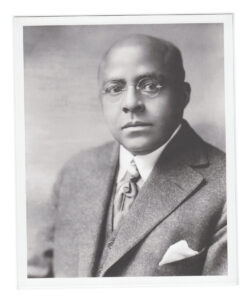
Black History Month is an annual celebration of Black Americans’ achievements and a welcome time for recognizing their central role in U.S. history.[1]
This year, the Coalition for the Homeless remembers Philip A. Payton Jr., a real estate entrepreneur, who was committed to breaking down racial barriers in the New York housing sector.

Payton’s efforts were instrumental in promoting Black social and economic progress by using a range of tactics to “open” white neighborhoods to Black residents, primarily in Harlem.[2]
He began his company, Afro-American Realty Company, turning Harlem into a magnet for Black families across the country. By 1904, the year the subway reached 145th Street and Broadway, his company was remaking Harlem as a home for Black citizens who faced discrimination and were often relegated to inhabitable conditions in other housing markets.[3]
Today he is commemorated as the “father of Harlem,” playing a pivotal role in initiating the Harlem Renaissance of the 1920s. His personal ambition, at a time when there was an abundance of unsold homes in Harlem and widespread racial discrimination elsewhere in the housing sector, resulted in a significant migration of three-quarters of New York City’s Black residents to the area,[3] ultimately building a thriving and supportive community.
Currently, New York City finds itself in a decades-long affordable housing crisis. In our Housing Affordability report, we point out that the City has failed to address the crippling lack of affordable housing that continues to fuel mass homelessness and drive a growing number of extremely low-income households into a state of perpetual housing instability.[4]
New York City does not have a homelessness crisis; it has an affordable housing crisis, and one that still, shamefully, disproportionately impacts Black New Yorkers. There is no question that systemic racism and mass homelessness are deeply intertwined, and that if we are ever to create a more humane and just approach we need our City and State leadership to implement solutions that match the scale of the need.[4] And we need to take inspiration from visionaries like Philip A. Payton Jr., who saw the opportunity to create not only homes, but community.
We remember Philip A. Payton Jr. and his impact because his business acumen and grit helped shape New York in the 20th century, setting numerous families up for enduring success for many years after his death.
His example and actions should inspire and encourage us to pursue solutions that lift up all New Yorkers and put future generations on the road to even greater success.
REFERENCES
[1] The History Channel: https://www.history.com/topics/black-history/black-history-month
[2] McGruder, K. (2021). INTRODUCTION. In Philip Payton: The Father of Black Harlem (pp. 1–10). Columbia University Press. http://www.jstor.org/stable/10.7312/mcgr19892.4
[3] Hassan, A. (2019). Philip A. Payton Jr.: a real estate magnate who turned Harlem into a Black Mecca. New York Times.[4] Coalition for the Homeless (2022) Housing Affordability: The Dire Housing Crisis for Extremely Low-Income New Yorkers, https://www.coalitionforthehomeless.org/wp-content/uploads/2022/05/Housing-Affordability-Brief_June-2022.pdf
[4] Coalition for the Homeless (2022) Housing Affordability: The Dire Housing Crisis for Extremely Low-Income New Yorkers, https://www.coalitionforthehomeless.org/wp-content/uploads/2022/05/Housing-Affordability-Brief_June-2022.pdf